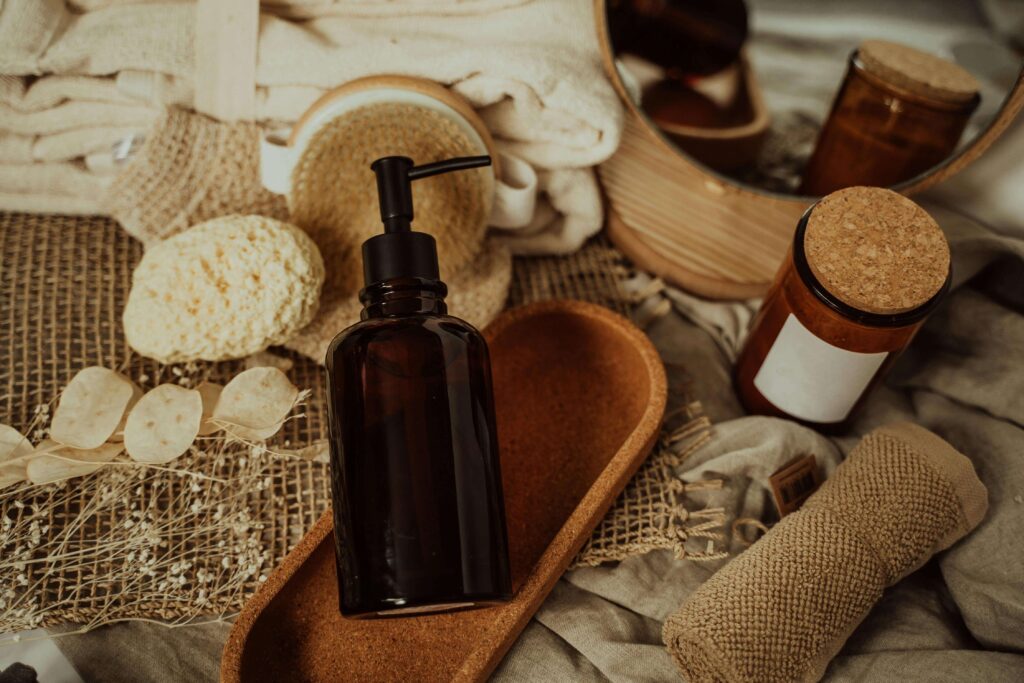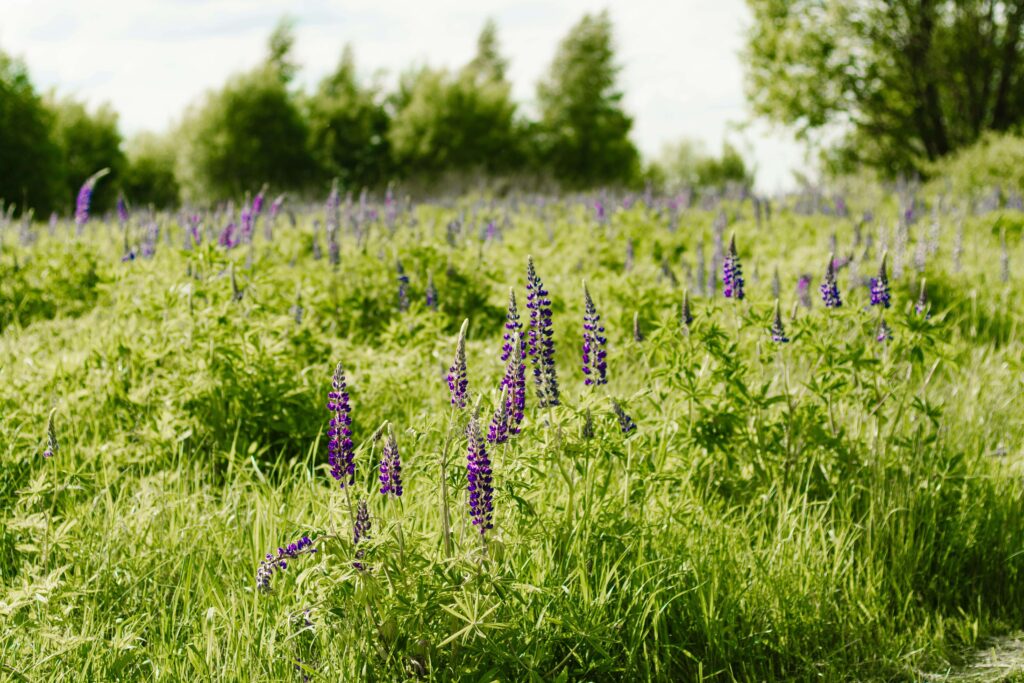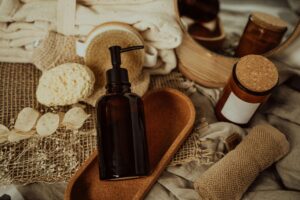Disclaimer: This post contains affiliate links, including links to Amazon. As an Amazon Associate, we earn from qualifying purchases at no additional cost to you. Thank you for supporting Low Tox & Thrive!
If you’re feeling overwhelmed by the endless choices in skincare—let alone narrowing them down to the least toxic but most effective options—this guide to natural skincare is for you.
Natural skincare isn’t just a trend. It’s a holistic approach to caring for your skin that celebrates the provisions of nature. In this comprehensive guide, we’ll explore the benefits of natural skincare, highlight essential ingredients, and help you create a personalized routine that suits your unique skin needs.
Why choose natural skincare?
Health benefits for your skin
Choosing natural skincare is a powerful way to prioritize your skin’s health. Conventional products often contain toxic ingredients, such as parabens, sulfates, and synthetic fragrances, which can lead to irritation and long-term damage. These chemicals can disrupt your skin’s natural barrier, resulting in issues like dryness, breakouts, or allergic reactions.
When you opt for natural skincare, you’re more likely to use products made from botanical ingredients that nourish and soothe. Think about it: would you rather apply a lab-created chemical or a nature-derived plant extract?
Eco-friendly practices
Caring for your skin can also mean caring for the earth. Many brands that focus on natural products emphasize sustainable sourcing and eco-friendly packaging. This means they often use ethically harvested ingredients and recyclable or biodegradable materials, which can significantly reduce your carbon footprint.
By selecting natural products, you’re supporting companies that prioritize environmental responsibility. This choice helps minimize pollution and preserve natural ecosystems. Additionally, many natural skincare brands are committed to cruelty-free practices, ensuring that no animals are harmed in the production process.
Proven effectiveness
The notion that natural products are less effective is a common misconception. In fact, many ingredients found in nature have been used for centuries and are backed by both tradition and scientific research.
For example, honey is a natural humectant, meaning it attracts and retains moisture, making it a powerful ingredient for hydration. And tea tree oil, with its potent antibacterial properties, has been a staple for treating acne, effectively reducing breakouts without the harsh side effects often associated with synthetic treatments.
With consistency and the right combination of products, you can achieve healthier skin while avoiding all the negative side effects that come with conventional skincare ingredients.
Essential natural skincare ingredients
When it comes to natural skincare, the ingredient list is key. Here we’ve compiled a list of ingredients commonly found in natural skincare products as well as what they’re used for. Look for these in the labels of ready-made products.
Alternatively, you can buy any of these ingredients on their own and add them into your routine as needed. If you choose to go this route, we’ve also included tips on how to use them as well as links to where to you buy them online.
| Ingredient (click to shop) |
Best for (skin type) |
Benefits | How to use | How much to use |
| Coconut oil | Dry, combination | Moisturizes skin and hair; antibacterial properties | Use as a moisturizer or makeup remover | 1 teaspoon daily or as needed |
| Jojoba oil | All skin types | Mimics skin’s natural oils; regulates oil production | Apply as a moisturizer or mix with other products | 2-3 drops for face daily; more for larger areas |
| Honey | All skin types, sensitive | Locks in moisture; has healing and antibacterial properties | Use as a mask or spot treatment for blemishes | 1 tablespoon for a mask 1-2 times a week; a few drops for spot treatment as needed |
| Aloe vera | Sensitive, irritated | Soothes and hydrates; rich in vitamins and antioxidants | Apply gel directly to the skin or mix into moisturizers | 1 tablespoon for face daily or as needed; more for larger areas |
| Tea tree oil | Oily, acne-prone | Antiseptic; reduces inflammation and kills acne-causing bacteria | Dilute with a carrier oil and apply to blemishes | 1-2 drops mixed with 1 teaspoon of carrier oil as needed for blemishes |
| Shea butter | Dry, mature | Deeply hydrates; improves skin elasticity | Apply as a moisturizer, especially on dry areas | A dime-sized amount for face daily; more for larger areas |
| Argan oil | Dry, all skin types | Nourishes and protects skin; reduces inflammation | Apply as a serum or mix into your moisturizer | 3-4 drops for face daily |
| Rosehip oil | Mature, scarred | Reduces appearance of scars and fine lines; anti-aging | Use as a facial oil, applying directly or mixing with moisturizer | 2-3 drops for face daily |
| Rose water | All skin types, sensitive | Hydrates and soothes skin; balances pH; helps tighten pores | Apply as a toner after cleansing or use as a facial mist throughout the day | 1 tablespoon for toning; spritz as needed for hydration |
| Lavender oil | Oily, all skin types | Balances oily skin; promotes relaxation; antiseptic properties | Add to skincare products | 1-2 drops mixed with 1 teaspoon of carrier oil daily or as needed |
Remember that less is often more. If you’re planning to use these ingredients on their own, rather than stocking up on each one, study this chart—specifically the “Best for” and “Benefits” columns. Then choose one or two to start with and build out or adjust your routine from there.
For example, you could try applying a couple drops jojoba oil to your face each night and adding honey to a face mask once a week (there’s a recipe for that below!). Try this for a month or two and see how your skin responds.
Maybe you’ll find the jojoba oil isn’t moisturizing enough or your skin is simply more on the dry side right now because of seasonality (hello, winter) and decide to switch it out for Argan oil instead. Or maybe you just got back from a tropical vacation and your skin is irritated from sun exposure, so you temporarily incorporate aloe vera into your daily routine.
Don’t be afraid to experiment until you find a customized skincare routine that works for you. Keep reading for pointers on building out this routine.
Building your natural skincare routine: Step-by-step breakdown
Creating a natural skincare routine doesn’t have to be daunting. Here’s a simple step-by-step breakdown to help you get started, with tips on what to look for in store-bought products as well as DIY options:
Step 1: Cleansing
Begin your routine with a gentle cleanser that effectively removes makeup, dirt, and impurities without stripping your skin of its natural oils. Look for options that contain soothing ingredients like chamomile or aloe vera.
For a thorough cleanse, consider using an oil-based cleanser. Coconut oil, for instance, is excellent for breaking down makeup while also providing hydration.
Store-bought options: Try one of these cleaners from Burt’s Bees or Thrive (opt for the unscented option).
DIY option: Use 1 teaspoon of coconut oil as an oil cleanser, massaging it into your skin before rinsing with warm water.
Step 2: Exfoliating
Exfoliation is essential for keeping your skin smooth and radiant by removing dead skin cells. Choose natural exfoliants such as ground coffee or brown sugar. These gentle options can help invigorate your skin without causing irritation. Aim to exfoliate 1-2 times a week to avoid overdoing it.
Store-bought options: Try one of these scrubs from M3 Naturals.
DIY option: Create a simple scrub using 1 tablespoon of brown sugar mixed with 1 tablespoon of coconut oil, gently massaging it onto your face in circular motions before rinsing.
Step 3: Toning
After cleansing, it’s important to restore your skin’s pH balance. Applying a toner can help refresh and prepare your skin for the next steps in your routine. Look for natural toners such as rose water or witch hazel. These ingredients can tighten pores and provide a soothing effect.
DIY option: Spritz your face with rose water after cleansing, or apply witch hazel with a cotton pad for targeted toning.
Step 4: Moisturizing
Hydration is crucial for all skin types to keep it soft and supple. Choose moisturizers with ingredients like shea butter, jojoba oil, or hyaluronic acid to lock in moisture without clogging pores.
Store-bought options: Try this face-and-body cream from Weleda or one of these serums from Beauty by Earth.
DIY option: Apply a dime-sized amount of shea butter to your face, or use 2-3 drops of jojoba oil to moisturize, adjusting the amount based on your skin’s needs.
Step 5: Treating
If you have specific concerns like acne or dark spots, add targeted treatments to your routine. For acne, tea tree oil is a powerful natural antiseptic that can help reduce breakouts. For brightening, a product with rosehip oil can effectively diminish dark spots and improve overall skin tone.
DIY option: Apply 1-2 drops of tea tree oil diluted in jojoba oil directly to blemishes as needed, or use 2-3 drops of rosehip oil as a serum for your entire face.
Tailoring to your skin type
Everyone’s skin is unique, so tailor your routine to your specific needs:
- Oily skin: Focus on lightweight gels and non-comedogenic products, such as gel-based moisturizers with jojoba oil.
- Dry skin: Opt for richer creams and oils, such as shea butter and argan oil, to provide intense hydration and nourishment.
Tips for selecting quality natural skincare products
When shopping for natural skincare products, keep these tips in mind:
- Read labels: Always check the ingredient list. If you find ingredients that are difficult to pronounce or seem synthetic, it might not be the best choice.
- Check certifications: Look for certifications like “USDA Organic” or “cruelty-free” labels to ensure product quality and ethical practices.
- Research brands: Choose brands that are open about their sourcing and manufacturing processes. A trustworthy brand will gladly share ingredient origins.
Avoiding harmful additives
As you embark on your natural skincare journey, you’ll need to know not only which ingredients to look for but which ones to avoid as well.
When reading the ingredients label, keep in mind that the ingredients are listed in descending order by weight. This means the first few ingredients make up the bulk of the product. Be extra cautious if the following harmful additives appear near the top of the list:
Parabens
Parabens are preservatives used to extend the shelf life of products and prevent microbial growth. However, they can mimic estrogen in the body, potentially disrupting hormonal balance. Studies have linked parabens to skin irritation and allergic reactions. Opting for paraben-free products helps you avoid these potential risks.
Sulfates
Sulfates, such as sodium lauryl sulfate (SLS) and sodium laureth sulfate (SLES), are often used in cleansers and shampoos for their foaming properties. While they are effective at removing dirt and oil, sulfates can strip the skin of its natural oils, leading to dryness and irritation. Choosing sulfate-free alternatives can help maintain your skin’s moisture barrier and prevent irritation.
Synthetic fragrances
Many products use synthetic fragrances to create appealing scents. However, these fragrances can contain numerous undisclosed chemicals that may trigger allergies, skin sensitivities, and respiratory issues. Some individuals might experience headaches or dizziness due to these artificial additives. Instead, look for products that use natural essential oils for fragrance, which can provide both pleasant scents and therapeutic benefits.
Phthalates
Phthalates are often used to enhance the flexibility and durability of plastics, but they can also be found in some cosmetics and fragrances. These chemicals have been linked to hormonal disruptions and reproductive issues, raising concerns about their long-term effects on health. By choosing phthalate-free products, you can reduce your exposure to these potential risks and support safer formulations.
Formaldehyde
Formaldehyde is commonly used as a preservative in various cosmetic products, including shampoos, nail polishes, and lotions. However, it is classified as a known carcinogen and can cause skin irritation, allergic reactions, and respiratory issues. Opting for formaldehyde-free alternatives helps protect your skin and overall health while promoting safer beauty practices.
Synthetic dyes
Synthetic dyes are often added to products for aesthetic appeal, labeled as “FD&C” or “D&C” followed by a color. While they enhance visual appeal, these dyes can irritate the skin and trigger allergic reactions in some individuals. Choosing products that use natural colorants or are free from synthetic dyes can help minimize irritation and support a more natural approach to skincare.
Avoiding greenwashing
In an era where “natural” and “eco-friendly” labels are becoming increasingly popular, it’s vital to educate yourself about greenwashing—a deceptive marketing practice where brands claim to be more environmentally friendly than they truly are. When evaluating products:
- Check for clear ingredient lists: Ensure the ingredient list is straightforward and easily understandable. If a product claims to be “natural,” it should contain primarily plant-derived ingredients without the presence of synthetic additives.
- Do your research: Look for independent reviews and third-party certifications that back up a brand’s claims. Check online resources or consumer reports that evaluate product efficacy and ingredient safety.
DIY natural skincare recipes
This wouldn’t be the ultimate guide to natural skincare without some DIY recipes to give you a kickstart! Here are a couple of easy recipes you can make with ingredients you likely already have in your home:
Hydrating face mask
Ingredients:
- 1 ripe banana
- 1 tablespoon honey
- 1 tablespoon yogurt
Instructions:
- Mash the banana in a bowl.
- Mix in the honey and yogurt until smooth.
- Apply to your face for 15 minutes, then rinse off with warm water.
Soothing body scrub
Ingredients:
- 1 cup brown sugar
- 1/2 cup coconut oil
- A few drops of lavender essential oil
Instructions:
- Combine all ingredients in a bowl.
- Use in the shower to exfoliate and hydrate your skin.
Embrace your natural skincare journey
As you begin your new skincare journey, remember that the information available in this guide to natural skincare is not meant to overwhelm you but to empower you. View it as a toolkit to make informed choices for your skin. Each step you take toward understanding natural ingredients is a victory, and you’re already on the right path.







